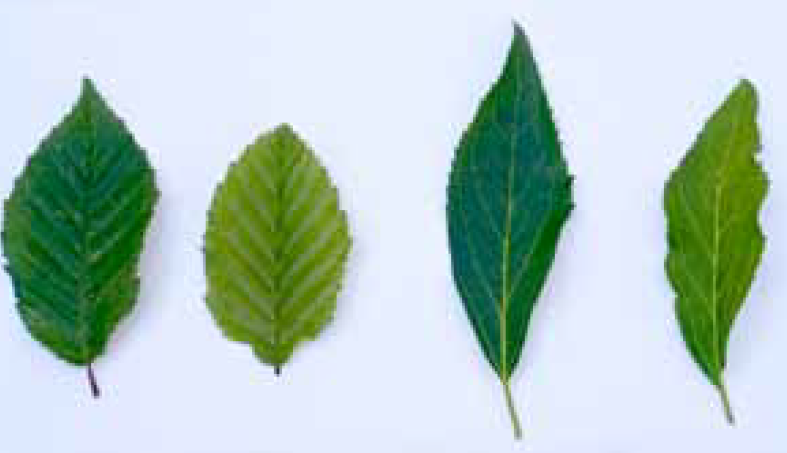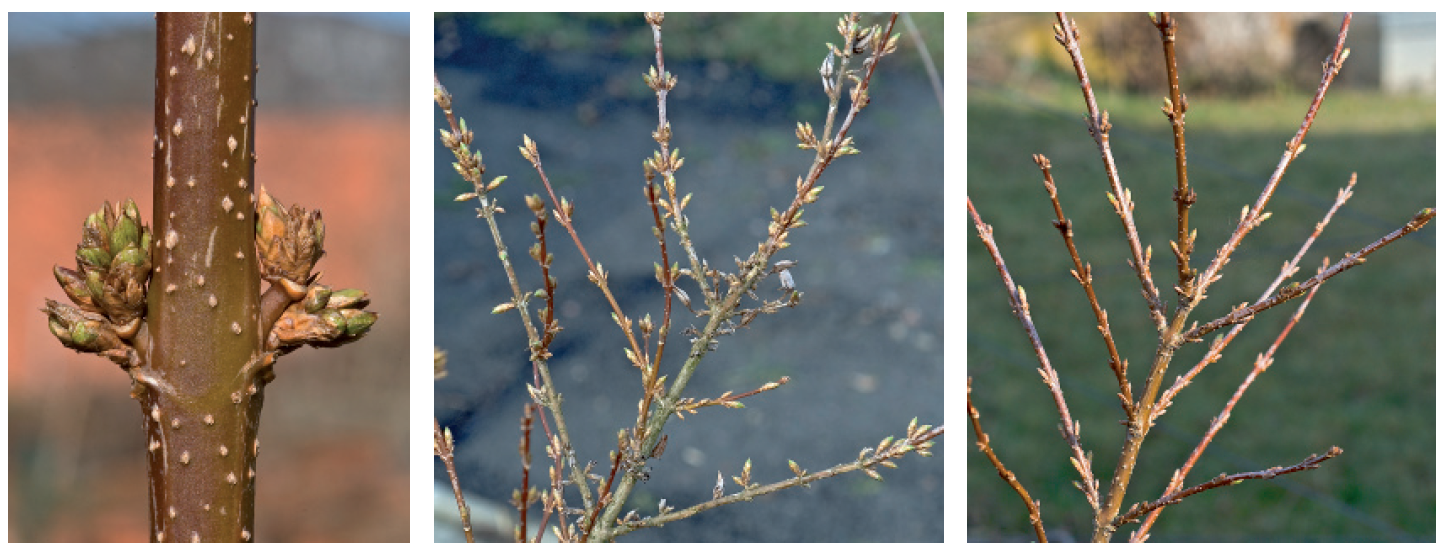Observations of Use
In 2006, various species and varieties of deciduous trees and shrubs were treated with Lithovit®. The following general observations were made:
- enlarged leaf area. Leaves more intensely green in colour
- accelerated increase in the length and thickness of shoots
- enhanced blossom and fruit formation with a simultaneous reduction in alternation
Leaf Area
Two varieties of hornbeam (Carpinus betulus and Carpinus betulus ‘Fastiagata Monument’) and one variety of forsythia (Forsythia intermedia ‘Lynwood’) were investigated. In all three cases, there were significant average increases in leaf surface areas:
- Carpinus betulus: leaf length +16 % (p < 5 %), leaf width +13 % (p < 5 %)
- Carpinus betulus ‘Fastigiata Monument’: leaf length +18 % (p < 5 %), leaf width +17 % (p < 5 %)
- Forsythia intermedia ‘Lynwood’: leaf length +27 % (p < 5 %), leaf width +40 % (p < 5 %)
The two leaves on the left are Carpinus betulus, the two on the right Forsythia intermedia ‘Lynwood’; in each case the left-hand leaf with Lithovit ® treatment, the right-hand leaf without.
Growth
The species and varieties already mentioned were investigated. Substantial acceleration in the growth of the hornbeam (Carpinus betulus) and of the forsythia (Forsythia intermedia ‘Lynwood’) was clearly observable. Numerous first-order offshoots reaching lengths of up to 20 cm formed directly on the hornbeam’s annual shoot (length up to 75 cm). The forsythia reacted to Lithovit treatment with an increased number of new ground shoots, which ultimately reached lengths of up to 2 m.
In the case of the columnar hornbeam (Carpinus betulus ‘Fastigiata Monument’), no difference was observed in the growth performance between the treated and the untreated plants.
Blossom and Fruit Formation
In addition to the forsythia (Forsythia intermedia ‘Lynwood’), a partial wintergreen variety of privet (Ligustrum vulgare ‘Atrovirens’) and honeysuckle (Lonicera henryi) were investigated.
In addition to the changes in leaf size and growth performance already described, it was observed in the case of the treated forsythia plants that the number of blossom buds was substantially increased as compared to the untreated plants.
Similar observations were made with regard to fruit-bearing trees and shrubs; in addition, the higher stress tolerance that is observable may lead to an improved quality of fruit.
Forsythia treated with Lithovit® (left-hand and centre pictures) produced considerably more buds than the forsythia not treated with Lithovit® (right-hand picture).
In the case of the privet and the honeysuckle, after blossoming which followed a normal pattern in all cases, a substantially increased level of fruit formation was observed in the plants treated with Lithovit®. Comparable observations were also made with dark-purple currants (Ribes atropurpureum).
On the basis of these effects, the use of Lithovit® leads to an attenuation of alternate bearing, as is also indicated by observations with olive trees (Olea europaea). Similar effects are found in fruit-bearing trees and shrubs.
Increased fruit formation in plants treated with Lithovit®: on the right privet, on the left honeysuckle.
Recommendations For Use
The quantity to be applied per hectare depends on the size of the plants to be treated. Generally, the Lithovit® solution should be used in a concentration of approx. 0.5 % (1 kg Lithovit® per 200 l water). Lithovit® can be mixed with customary plant protection agents, to the extent that these are not applied in the form of an acid solution. Since not all chance occurrences that may arise in practice are predictable, users are recommended to test a trial mixture first.
Ornamental and Forestry Trees and Shrubs
- 1st application during foliation (approx. 10-15 days after beginning)
- 2nd application during second foliation (Lammas shoot)
Fruit-bearing Trees and Shrubs
- 1st application during foliation
- 2nd application three to four weeks after the end of flowering
- 3rd application early to mid-July
- (optional; very much to be recommended for fruit-bearing trees and shrubs that react in a particularly negative manner to physiological stress or a lack of trace elements)



